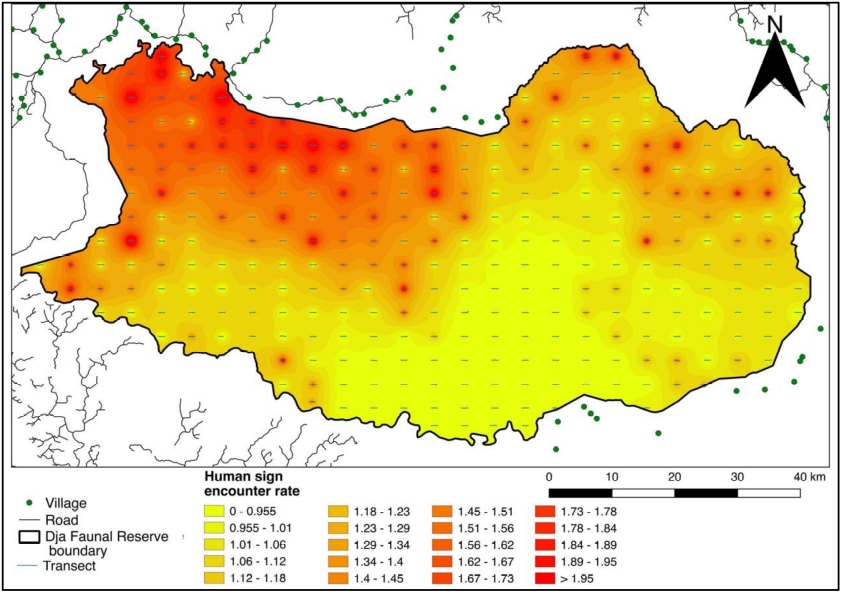The The Status of Forest elephant in the world heritage DJA Faunal Reserve, Cameroon
DOI:
https://doi.org/10.69649/pachyderm.v61i.19Abstract
Central African forest elephants (Loxodonta cyclotis) have declined by an estimated 62% between 2002 and 2011, largely as a result of poaching for the illegal ivory trade. They are now considerably more threatened than the Vulnerable African savannah elephant (Loxodonta Africana), and effective monitoring of refugia populations is essential to inform management and conservation plans to secure a future for this megafaunal species.
Our forest elephant dung-based distance-sampling survey of the 5,260 km2 World Heritage Dja Faunal Reserve (DFR) in Cameroon systematically covered 298.2 km of line transects with a further 1,681.4 km covered as recces. The population estimates of 0.042 individuals/km2 (CV: 19.4%; 95% CI: 0.029–0.061) and 219 individuals (95% CI: 150–319) confirmed a significant decline over recent years. The low density of forest elephants in the DFR reflects similar losses experienced in other parts of Central Africa such as the heavily impacted Korup National Park (0.04 individuals/km2).
Elephants now mainly persist in pockets within the northern part of the DFR, where the Cameroon Ministry of Forests and Fauna (MINFOF) has initiated a community support partnership agreement on sustainable access to forest resources, and increased law enforcement patrols and rapid response. The southern sector of the DFR is much more vulnerable to organised wildlife crime gangs operating from trafficking hubs outside traditional communities. The DFR management is implementing a community surveillance network and increasing SMART based patrolling, especially along the DFR’s southern boundary, as well as in the south-eastern corner to secure the only existing forest elephant corridor. With improved security and appropriate engagement with local communities and private sector operators in the region, the remaining elephant population should start to expand across the DFR and its buffer zone, and numbers gradually increase across the wider landscape.
Résumé
Les éléphants de forêt de l'Afrique centrale (Loxodonta africana cyclotis) ont diminué d'environ 62% entre 2002 et 2011, ceci en grande partie à cause du braconnage pour le commerce illégal de l'ivoire. Ils sont à présent plus menacés que l‘ éléphant de savane (Loxodonta africana) et un suivi efficace de ces populations refuges est essentiel pour la mise à jour et l’implemenation des plans de gestion afin d'assurer un avenir pour cette espèce de mégafaune.
Cet inventaire par la méthode distance sampling a permis de couvrir 5,260 km2 de la Réserve de Faune du Dja (RFD) site du patrimoine mondial avec 298.2 km de transects linéaires et 1,681.4 km de recces. Une estimation de la population d’éléphants à 0.042 individu/km2 (CV: 19.4%; IC à 95%: 0.029 à 0.061) et 219 individus (IC à 95%: 150 à 319) a confirmé un déclin significatif de la population de cette espèce au cours des dernières années. La faible densité d'éléphants de forêt dans la RFD reflète les tendances à la baisse observées dans d'autres parties de l'Afrique centrale telle que le Parc National de Korup, fortement touché (0.04 individu/km2).
Les éléphants persistent maintenant principalement dans les poches du la partie RFD, principalement dans les poches du secteur nord de la RFD où le Ministère Forêts et de la Faune (MINFOF) du Cameroun à initier un accord de partenariat d’appui aux communautés pour l'accès durable aux ressources forestières en plus de l‘intensification des patrouilles de surveillance et de réponses rapides. Le secteur sud de la RFD semble être plus vulnérable aux gangs de la criminalité faunique opérant à partir de petites localités qui échappent à l’influence des communautés locales. L’unité de gestion de la RFD met en œuvre un réseau de surveillance communautaire et augmente les patrouilles avec l‘approche SMART, en particulier le long des limites Sud et Sud-Est de la RFD pour sécuriser le seul possible couloir de migration des éléphants de cette aire protegée. Avec une protection améliorée, une implication appropriée des communautés locales et des opérateurs du secteur privé opérant autour de la RFD, la population d'éléphants restants devrait commencer à augmenter à l’interieur puis dans la zone tampon avant de progressivement se redistribuer dans l'ensemble du paysage.




